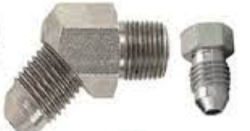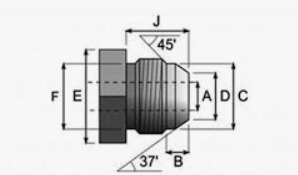The JIC standard stands out as a crucial benchmark in the ever-evolving landscape of industrial standards. It significantly influences various sectors. This comprehensive guide aims to demystify the intricacies of the JIC standard. It provides a thorough understanding of its significance and applications.
Historical Context of JIC Standard
The JIC standard traces its roots back to the mid-20th century. Industrial pioneers recognized the need for standardized fluid connectors. The JIC standard started as a basic set of guidelines. It has matured into a sophisticated system. This system ensures compatibility and reliability in hydraulic applications.
As technology advanced, so did the JIC standard. Continuous refinement and adaptation to new materials and manufacturing processes have kept this standard relevant across decades. It is a timeless benchmark in the fluid power industry.
Understanding JIC Terminology
➡️ JIC Flare Fittings
At the core of the JIC standard are flare fittings, designed with precision to create leak-proof connections. It is crucial to understand the variations in cone angles and the materials used in these fittings. This understanding is crucial for ensuring optimal performance in fluid systems.
➡️ JIC Thread Standards
The JIC standard extends to thread specifications, providing guidelines for creating robust threads. It is essential to understand the differences between SAE J514 and ISO 8434-2 standards. Also, it is crucial to appreciate the importance of thread integrity when decoding the JIC standard.
Key Components of the JIC Standard
➡️ Flare Fittings Design
The intricate design of JIC flare fittings involves considerations like cone angle variations. It also involves the selection of materials. Each element plays a role in creating connections. These connections withstand the rigors of industrial applications.
➡️ Thread Specifications
Understanding the differences between SAE J514 and ISO 8434-2 standards sheds light on the need for uniform threading. Delving deeper into this comparison is important to see why uniformity in threading matters. Ensuring thread integrity is not just a recommendation. It is a fundamental requirement for maintaining system integrity.
Applications Across Industries
➡️ Automotive Sector
The automotive industry widely embraces the JIC standard. It relies on its specifications for fluid connections. They endure the challenges of vehicular operations.
➡️ Aerospace Industry
The aerospace sector demands precision and reliability. The JIC standard is used in hydraulic systems that power critical flight components.
➡️ Hydraulic Systems
Hydraulic systems adhere to the JIC standard in construction and manufacturing. The standard fosters compatibility and facilitates seamless integration of components.
Advantages of Adhering to JIC Standard
1. Interchangeability and Compatibility
Adhering to the JIC standard ensures that components from different manufacturers can seamlessly work together. This interchangeability not only simplifies procurement but also allows for greater flexibility in designing and maintaining industrial systems.
2. Reduced Downtime
In industries where downtime translates to revenue loss, the JIC standard proves to be a game-changer. The standardized components facilitate quicker replacements and repairs. They minimize the time a system remains non-operational.
3. Enhanced Safety
Consistency in components is mandated by the JIC standard. It contributes significantly to system safety. Knowing that every part adheres to a standardized specification provides assurance against unforeseen failures. It promotes a safer working environment.
Implementing JIC Standard: Best Practices
➡️ Thorough Training
To fully harness the benefits of the JIC standard, invest in comprehensive training for personnel. This includes those involved in system installation, maintenance, and repairs. It is imperative. This ensures that everyone understands and follows the prescribed guidelines. It fosters a culture of adherence.
➡️ Regular Audits and Inspections
Routine audits and inspections are crucial to verify compliance with the JIC standard. This proactive approach helps identify potential issues before they escalate. It maintains the integrity of industrial systems.
➡️ Documentation and Record-Keeping
Accurate documentation is the backbone of JIC standard compliance. Keeping detailed records of components, installations, and maintenance activities not only facilitates regulatory compliance but also streamlines future troubleshooting.
Common Challenges and Solutions
➡️ Thread Sealing Issues
Overcoming challenges like thread sealing issues involves a meticulous approach. Selecting the right sealant and applying the proper torque are critical steps. They ensure leak-free connections.
➡️ Corrosion and Material Considerations
Corrosion poses a threat to any hydraulic system. Understanding material considerations and implementing corrosion-resistant components are proactive measures to address this challenge.
JIC Standard vs. Other Hydraulic Standards
➡️ A Comparative Analysis
When comparing the JIC standard with other hydraulic standards, it’s clear that they have nuanced differences in design philosophies. Understanding these distinctions is crucial for industries. They must select the most suitable standard for their specific applications.
“➡️ Difference Between JIC And BSP Connectors ⬅️”
“➡️ JIC Vs AN Fittings: The Differences For Precision Connections ⬅️”
➡️ Industry Preferences
Industries often develop preferences for specific standards based on historical use, regional practices, or industry-specific requirements. Analyzing these preferences sheds light on the dynamic landscape of hydraulic standardization.
JIC Standard Compliance Certifications
➡️ Navigating Compliance Processes
Achieving and maintaining JIC standard compliance involves navigating specific processes. Industries committed to the standard must understand the certification requirements. They must also ensure ongoing compliance.
➡️ Certification Agencies and Authorities
Various agencies and authorities oversee JIC standard compliance. Familiarizing oneself with these entities and their requirements streamlines the certification process. It also ensures adherence to the highest industry standards.
Ensuring Safety Through JIC Standards
➡️ Importance in High-Pressure Systems
In high-pressure systems, adherence to the JIC standard is paramount. The standard’s specifications ensure the integrity of connections. They mitigate the risks associated with elevated fluid pressures.
➡️ Risk Mitigation Strategies
Developing and implementing risk mitigation strategies aligned with JIC standards safeguards industrial operations. These strategies encompass preventive measures, regular inspections, and proactive maintenance protocols.
Conclusion
The JIC standard is an anchor in fostering efficiency, safety, and compatibility across diverse industrial landscapes. Adhering to the JIC standard is a strategic choice. It pays dividends in the long run. This applies whether in hydraulic systems, manufacturing processes, or beyond.
Encouraging industry-wide adherence to the JIC standard fosters a collaborative approach to fluid system standardization. Industries continue to evolve. The JIC standard remains a beacon, guiding them toward a future where compatibility, reliability, and safety are non-negotiable.
This in-depth guide serves as a testament to the enduring relevance and importance of the JIC standard in the intricate tapestry of industrial fluid systems.
Post time: Dec-15-2023



